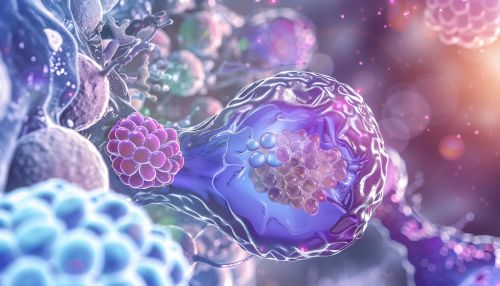Multiple endocrine neoplasia type 1
Overview
Multiple endocrine neoplasia type 1 (MEN1) is a rare hereditary disorder that primarily affects the endocrine glands. It is characterized by the development of tumors in the parathyroid, pituitary, and pancreatic islet cells. The condition is caused by mutations in the MEN1 gene, which provides instructions for producing a protein that acts as a tumor suppressor.


Genetics
MEN1 is an autosomal dominant disorder, meaning that an individual only needs to inherit one copy of the faulty gene from one parent to develop the condition. The MEN1 gene is located on chromosome 11 and encodes a protein called menin. Menin is involved in several processes within the cell, including DNA repair and replication, transcription regulation, and cell division. Mutations in the MEN1 gene disrupt the function of menin, leading to uncontrolled cell growth and the formation of tumors.
Clinical Features
The clinical features of MEN1 vary widely and can appear at any age, although most individuals start showing symptoms in their 20s or 30s. The most common manifestation of MEN1 is hyperparathyroidism, which is caused by overactive parathyroid glands. This can lead to kidney stones, bone disease, and gastrointestinal disturbances. Tumors in the pituitary gland can cause a variety of symptoms depending on the type of hormone they produce. Pancreatic islet cell tumors are also common and can lead to conditions such as Zollinger-Ellison syndrome or insulinomas.
Diagnosis
Diagnosis of MEN1 is based on clinical criteria, genetic testing, and family history. The clinical criteria include the presence of two or more primary MEN1-associated endocrine tumors (parathyroid, pituitary, or pancreatic). Genetic testing can confirm the diagnosis by identifying a mutation in the MEN1 gene. However, not all individuals with MEN1 will have a detectable mutation, so a negative genetic test does not rule out the condition. A family history of MEN1 can also support the diagnosis.
Treatment
Treatment for MEN1 is tailored to the individual and depends on the type and location of the tumors, as well as the patient's age and overall health. Surgery is the most common treatment for MEN1-associated tumors. Medications may also be used to manage symptoms and control hormone levels. Regular monitoring is essential to detect new tumors and manage existing ones.
Prognosis
The prognosis for individuals with MEN1 varies depending on the type and location of the tumors, as well as the individual's response to treatment. With early detection and appropriate management, most individuals with MEN1 can lead normal lives. However, complications can arise from the tumors and their treatment, and some tumors may become malignant.
Epidemiology
MEN1 is a rare condition, affecting approximately 1 in 30,000 individuals worldwide. It occurs in all ethnic groups and affects both sexes equally. The condition is usually diagnosed in adults aged 20-50, but it can appear at any age.
Research Directions
Current research on MEN1 is focused on understanding the function of the MEN1 gene and its associated protein, menin. Researchers are also investigating new treatments for MEN1-associated tumors, including targeted therapies and immunotherapies.
